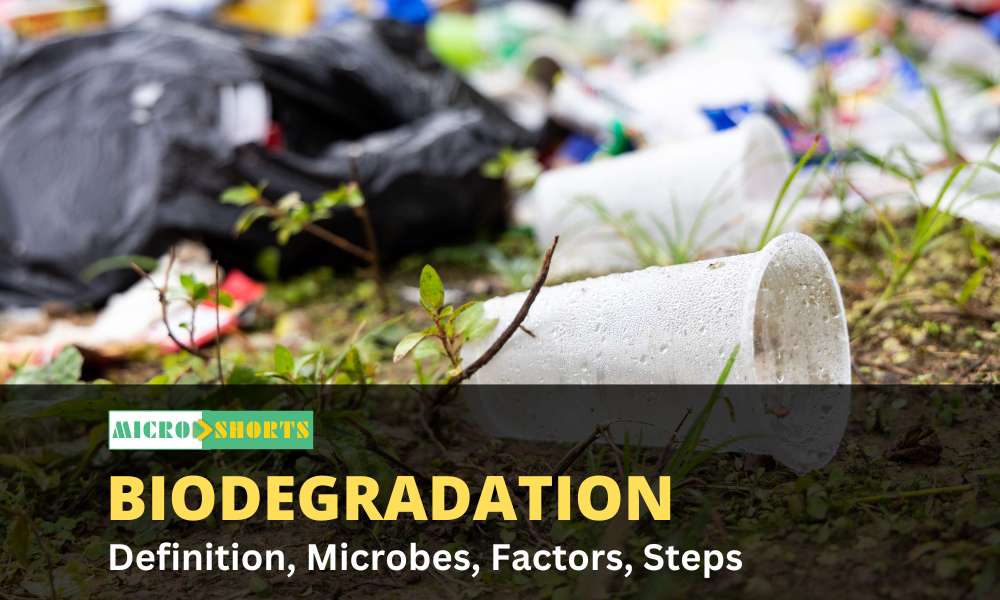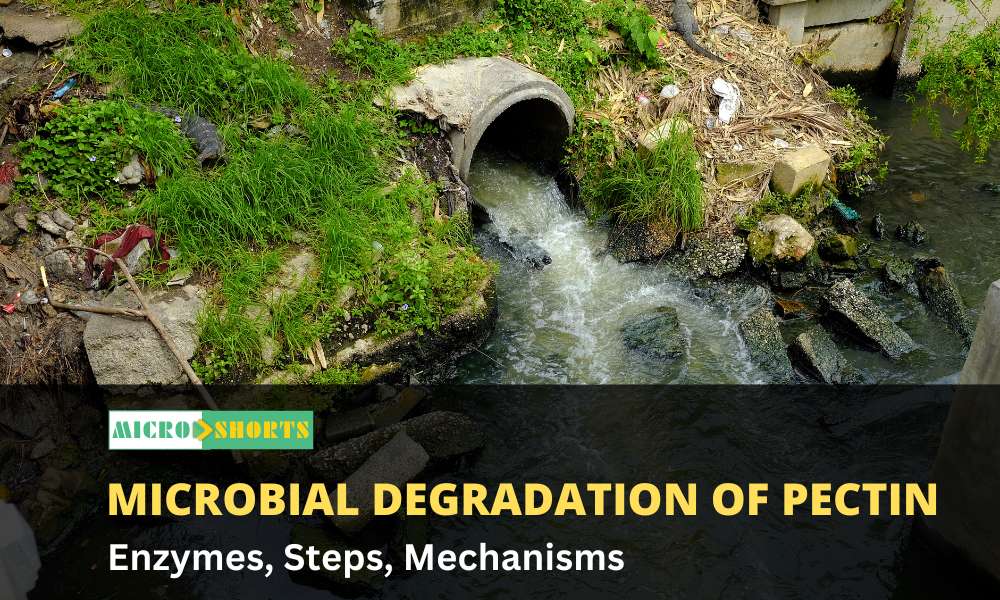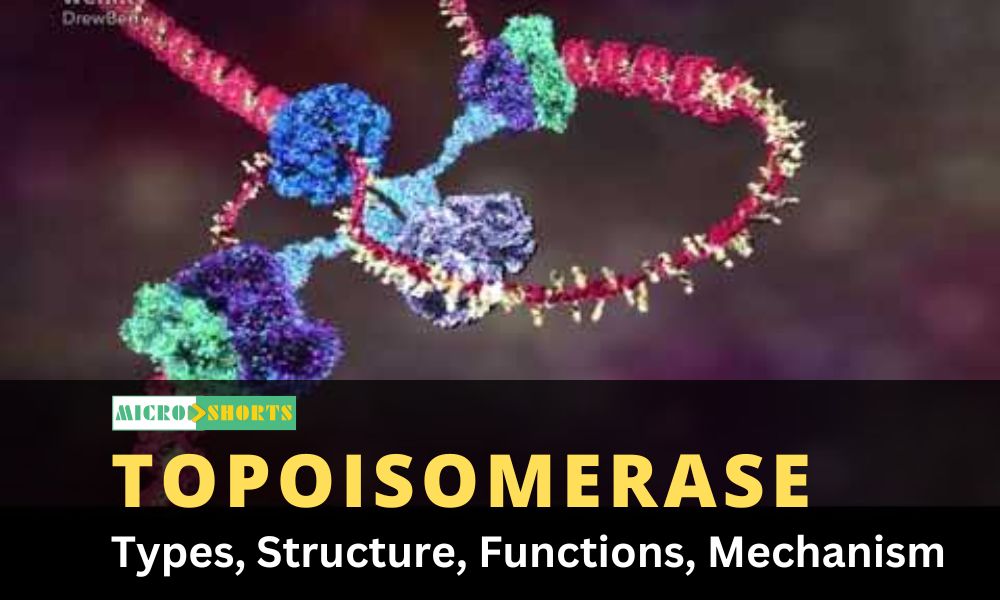Biodegradation is a natural process, whereas
Bioremediation is a man-made biotechnological process.
Both these processes are very important for cleaning and
recycling environmental resources.
Biodegradation refers to the breaking down of organic
matter, and Bioremediation refers
to the breakdown of toxic environmental pollutants into simpler molecules. The
common factor between both processes is the use of microorganisms to carry out
the chemical reaction required in the breakdown of complex matter. The article
provides in-depth knowledge of both processes.
What is Biodegradation?
Biodegradation is the breakdown of organic matter or
substances into smaller and simpler substances via a biologically catalyzed
reduction in the presence of living microorganisms.
Biodegradation is a general term used for any change or
breakdown in a substrate that is biologically mediated.
Biodegradable matter can be metabolically degraded by
microbes in the presence of oxygen (aerobically) or in the absence of oxygen
(anaerobically). Almost any matter living or non-living, is subjected to
biodegradation. The only key element is the ‘duration’ of that matter
breakdown. European Union has set a standard biodegradability for materials
that 90% of the original substance to be degraded to water, mineral, and carbon
dioxide by biological reactions within six months.
The process is brought about by the metabolic and enzymatic
actions of microorganisms like bacteria, yeast, and fungi. Microorganisms
follow any two modes for biodegradation based on the type of matter and
environment. They are Minerilization and Cometabolism. Mineralization is a complete
degradation of organic pollutants where organisms use matter as the sole source
of carbon to produce energy. Whereas in Cometabolism, it is observed that
degradation is done by the addition of a growth substrate as a primary source
of carbon and energy to initiate the breakdown of matter. Some naturally
occurring microbes show excellent catabolic activity to transform and degrade a
wide range of compounds like polychlorinated biphenyls, hydrocarbons (eg.
oils), radionuclides, metals, and more.
Biodegradation is referred to as one of the most favored and
sustainable measures of removing any complex organic matter and is often
regarded in terms of ecology, the natural environment, and waste management.
Biodegradable Pollutants
Since the time of the industrial revolution and with an
increased standard of living, numerous highly toxic organic compounds such as
fuels, polycyclic aromatic hydrocarbons (PAHs), dyes, pesticides, and some
synthetic chemicals like radionuclides have been synthesized and released for
use in the environment for a long period of time for direct or indirect
application. These toxic and complex compounds are difficult for the native
flora to readily degrade upon release into the environment. Some of the organic
pollutants are mentioned below.
Polycyclic Aromatic Hydrocarbons (PAHs)
Hydrocarbons are organic molecules composed of hydrogen and
carbon as the primary functional units of a compound. They are either aliphatic
in nature (linear and branched compounds) or aromatic (compounds with a benzene
ring). Aliphatic compounds include alkanes, alkene, and alkynes, while
aromatic compounds include a benzene ring, such as phenols, toluene, etc.
PAHs have been categorized as an important organic pollutant
in the ‘Hydrophobic Organic Contaminants (HOCs)’ class that’s
readily found in sediments, soils, and air.
- They
are present naturally in gasoline, crude oil, and coal.
- They
can be formed by burning coal and wood and also while cooking meat in high
heat.
- PAHs
can be easily bound to and form minute particles that can get accumulated
in organisms.
- In
the United States, a man-made PAH called the ‘Naphthalene’ are used
to make mothballs and other chemicals.
- Cigarette
smoking also releases many PAHs into the environment.
- They
can get accumulated in the fish and other aquatic organisms, which can be
transferred to humans when consuming seafood.
- In
the NHANES (National Health and Nutrition Examination Survey) of
2003-2004, CDC Scientists measured the urine sample of 2,504 individuals
aged from six years old to above and found ten different PAH metabolites.
- Higher
exposure to Naphthalene and other PAHs present in the air can irritate
eyes and nasal passages and can also cause liver problems.
Polychlorinated Biphenyls (PCBs)
PCBs are categorized as man-made chemicals with an oily
texture, no taste or smell, and are yellow in color. Found in air,
water, sediments, and soil across the world.
- They
are chemically very stable mixtures, highly resistant to high
temperatures, non-flammable, and with electrical insulation
properties.
- Due
to these features, they are widely used in hydraulic and
electrical equipment, as plasticizers in rubber products, and as pigments
in dyes.
- Once
released in the environment, they are easily spread across long distances
via air and soil, making them persistent in the atmosphere.
- Humans
are generally exposed to PCBs by consuming contaminated meat, fish, dairy
products, fruits, and vegetables.
- They
are absorbed and stored in the fatty tissue, which can cause cancer and
act as an endocrine disruptor.
- PCBs
were sold commercially by the name of Aroclor by the company named
Monsanto Inc. in the United States. The levels of PCBs have been declining
in the food chain and environment since its ban in 1977 due to its
exposure which led to ill health effects.
Pesticides
The concept of a pesticide is a combination of
poisonous compounds that target pathogens and is safe for non-pathogens like
humans and animals. They belong to a class of chemicals that includes
herbicides, fungicides, rodenticides, molluscicides, plant growth regulators,
insecticides, and nematicides, used to regulate the growth of weeds, killing of
pests, and prevention of diseases.
- Pesticides
use enhances the productivity of crops and the prevention of vector-borne
diseases.
- The
United States is one of the world’s largest traders, producers, and
consumers.
- Pesticides
cause a serious health hazard to non-target organisms because they are
readily fat solubility and bioaccumulation.
- The
introduction of pesticides leads to a decline in the population of
zooplankton and phytoplankton
- They
can be neurotoxic and carcinogenic and decrease fertility in fishes,
invertebrates, insects, mammals, and amphibians.
- Regular
use of their presence develops resistance to pests, reducing their toxicity.
- The
biodegradation of pesticides is mostly done by soil microorganisms using
it as a food source, whereas persistent xenobiotics become incorporated
into the environment leading to biomagnification.
Dyes
They have applications in a wide range of industries, such
as cosmetics, textiles, pharmaceuticals, rubber products, and more.
- The
most dye used are Azo dyes that contain diazotized amine coupled
with phenol or an amine group and single or more azo (–N=N–) groups.
- Microorganisms
have potential oxidoreductive enzymes and a dynamic metabolism ability
that allows them to use dyes with complex xenobiotic compounds as a
substrate, helping in the decolorization of polluted sites.
Radionuclides and Heavy metals
An atom has a highly unstable nucleus with the ability to
impart excess energy during the radiation process in which they undergo
radioactive decay to produce subatomic alpha or beta particles or emission of
gamma rays. Microbial degradation of radionuclides results in the
formation of less toxic and more stable compounds.
Heavy metals, such as arsenic, cadmium, chromium, etc,
cannot be destroyed like organic compounds but can be converted into stable
forms. The mechanism applied by microbes includes:
- Bioleaching –
mobilization of heavy metal through methylation reactions or excretion of
organic acids
- Biosorption –
metal absorption in the cell surface.
- Enzyme-catalyzed
redox reactions.
- And
Intracellular accumulation of heavy metals.
- Extraction of
heavy metals can be achieved by recovering the precipitate of metals from
microbial samples.
Microorganism in Biodegradation and their Impact
In nature, biodegradation is a natural process that is
carried out to recycle wastes and break down complex and toxic organic
compounds into a much simpler form that can be reused as a food source by other
organisms. Microorganisms, such as bacteria, fungi, and yeast, are the most
common species that help in the biodegradation process.
Bacterial Strain
Bacteria constitute a key organism in the biodegradation
process, which can be easily isolated from any place.
- Bacterial
strains from genus Klebsiella, Enterobacter, Bacillus,
Staphylococcus, Acinetobacter, and more belong to the
hydrocarbon degradation category. Brevibacillus and Pseudomonas species,
anaerobically reduced nitrate-containing compounds, have been isolated
from the petroleum-contaminated soil.
- The
genera of gram-negative strains like Pseudomonas, Aeromonas,
etc, carry out biodegradation of aromatic hydrocarbons.
- A
mixed population of bacterial strains is better suited to degrade
pollutants as they can easily share genetic information related to
degradative enzymes and pathways.
- PCB
degradation is carried out aerobically and anaerobically by redox and dehalogenation
reactions. PCB degrading activity is shown by both Gram-positive
(eg. Rhodococcus, Bacillus, Microbacterium, and more) and
Gram-negative strains (genera Pseudomonas, Sphingomonas, Ralstonia,
etc.).
- PCB
degradation incorporates these four enzymes biphenyl dehydrogenase,
dihydro diol dehydrogenase, 2,3-dihydroxy biphenyl dehydrogenase, and
hydrolase.
- Pesticides
such as DDT (Dichlorodiphenyltrichloroethane) are degraded by the
strains Staphylococcus and Stenotrophomonas bacteria, and
‘Chlorpyrifos’ pesticide degrading bacteria is Providencia
stuartii.
- Shewanella
decolorations are identified as a single bacterium species that can
efficiently remove azo dyes.
- Heavy
metals are transformed via a dissimilatory metal reduction process where
bacterial species use metals as a terminal electron acceptors during
respiratory reactions. Acidithiobacillus ferrooxidans,
an acidophilic iron bacteria, and sulfur-oxidizing bacteria are found to
have high concentrations of Arsenic, Cadmium, Zinc, Cobalt, and Copper
from contaminated soils.
Plant Growth Promoting Bacteria (PDPB and PGBR)
These bacteria can be generally found in the plants
naturally, in roots, or near them. They are non-pathogenic to plants
and help in the growth and development of plants. Plants and plant
growth-promoting bacteria live in mutualistic relationships, wherein plants
give shelter, and food sources, and bacteria, in return, help in metabolizing
toxic substances that can be used by plants.
- Pseudomonas
species and Lysini bacillus show PAH hydrocarbon degrading activity that’s
released from plants.
- Strains
of the genus Luteibacter, Williamsia, and Rhodobacter have
shown a promising PCB degradation activity present in the contaminated
soil.
- Azospirillum
lipoferum, isolated from the rhizoplane of crop plants, is
observed to degrade Malathion, an organophosphorus insecticide.
Fungal Species
They are considered the principal microorganism important
for the carbon decomposition in the atmosphere. They can easily survive in the
low pH and moisture areas. They are highly equipped with special extracellular
multienzyme complexes helping in the degradation of natural polymeric
compounds.
- With
the aid of their hyphal structures, they are able to colonize and easily
penetrate substances, helping them to redistribute nutrients across the
mycelium.
- Recycling
of recalcitrants like lignin is implicated by the degradative mechanisms
of fungi.
- Toluene-degrading
fungi include deuteromycetes species belonging to the genera Exophiala,
Leptodontium, and Cladophialophora, and an ascomycete
strain Pseudeurotium zonatum, that utilize toluene
for carbon and energy sources.
- Filamentous
fungi Cladosporium and Aspergillus show the degrading activity of
aliphatic hydrocarbon, whereas fungi that belong to Penicillinum,
Fusarium, and Cunninghamella degrade aromatic
hydrocarbons.
- Aspergillus
niger has shown biodegrading activity towards PCBs.
- Fungi
detoxify metals via mechanisms like active uptake, transformation, and
extra or intracellular precipitation. Examples include Rhiloprzs
arrhizus and Aspergillus niger.
Yeast
Yeast species have been heavily studied to degrade
Poly Aromatic Hydrocarbons (PAHs) and use them for energy-dependent
uptake systems. Trichosporum cutaneum, a soil yeast, has been seen to degrade
phenols.
- Alkanes
of 10 to 20 carbons are degraded by species like Candida
lipolytica, Rhodotorula aurantiaca, Candida ernobii, and more.
- Candida
methanosorbosa BP-6 species have been reported to potentially
break down azo dye like aniline.
- Saccharomyces
cerevisiae, Candida biodinii, and several others can
transform plasticizers, insecticides, fungicides, and polychlorinated
biphenyls (PCBs) into simpler forms.
- Yeast
strains such as Hansenula polymorpha, Cyberlindnera fabianii,
Rhodotorula pilimanae, etc, accumulate heavy metals like Cr, Co, Ni,
Mg, and other heavy metals and reduce metals via redox reactions.
Genetically-Modified Microorganisms (GMM)
Genetically-modified microorganisms have altered genetic
material inspired by the microorganisms’ gene transfer methods using genetic
engineering like DNA Recombinant Technology. GMMs have shown great
potential with enhanced biodegradation capabilities for various chemical
contaminants.
The main aspects to be kept in mind for GMM development in
the biodegradation application are:
- Enzyme
specificity and affinity modifications.
- Regulation
and construction of metabolic pathway.
- Development,
monitoring, and control of Bioprocesses.
- Bioreporter
sensory application for toxicity reduction, chemical sensing, and
end-point analysis.
Construction of upgraded genetic modules and new catabolic
pathways for biodegradation in microbes require separate plasmids for every toxic
compound. These plasmids are categorized into four groups:
- OCT
plasmids – degradation of hexane, octane, and decane.
- XYL
plasmids – degrade toluenes and Xylene.
- CAM
plasmids – decomposition of Camphor compound.
- NAH
plasmids – degradation of Naphthalene.
Examples of genetically-engineered microorganisms (GEM)
include:
- GMM Pseudomonas
putida with multi-plasmid capabilities is often referred to as
Superbug (Oil Eating Bug) that contains pKF 349 for salicylate toluene,
pAC 25 (for 3-cne chlorobenxoate degradation), in addition to XYL, NAH,
OCT, and CAM plasmids.
- For
the removal of Chromium in industrial wastewater, Alcaligenes eutrophus
AE104 (pEBZ141) are used for degradation.
- Rhodopseudomonas
palustris, a recombinant photosynthetic bacterium, is used for mercury
removal from wastewater.
- PCB
(polychlorinated biphenyls) are degraded by using GEM Achromobacter sp.
LBS1C1 and A. denitrificans JB1.
The use of GMM strains for biodegradation and bioremediation
purposes can cause competition with wild-type species in a mixed culture. The
controversy surrounding GMM release into the environment must be overcome by
proper field testing, biosafety, and the reduction in potential damage to the
ecosystem.
Stages of Biodegradation
The biodegradation process can be subdivided into three
processes – Biodeterioration, Bio-fragmentation, and Assimilation. Biodeterioration
refers to the process of mechanical weakening of complex structures. In
Bio-fragmentation, microorganisms break down toxic and complex compounds. And
in Assimilation, old structures are transformed into new compounds.
Biodeterioration
The process involves the mechanical, physical, and chemical
weakening of the compound structure. The abiotic factors, such as light,
temperature, and chemicals of the environment, initiate these changes.
Bio-fragmentation
After the weakening of the structure, the cleavage of
polymeric bonds leads to the transformation of oligomers and monomers. The
fragmentation is achieved in aerobic as well as in anaerobic conditions. Aerobic
digestion of compounds leads to the formation of water, carbon dioxide, and
simple molecules that are utilized as a nutrient source. Anaerobic
digestion reduces the mass and volume of complex material, such as the
production of natural gases. Anaerobic reactions are used widely used in waste
management facilities as a source of renewable energy.
Assimilation
The newly formed molecules are taken up by the
microorganisms via membrane carriers. The molecules are then used as an energy
source in the form of ATP (Adenosine Triphosphate) or as cell structural
elements.
Factors Affecting Biodegradation
Biodegradation of materials and its rate of degradation by
microorganisms is influenced by nutritional requirements and environmental
factors like soil, water, etc. The efficiency and rate of degradation depend on
the compounds’ concentration, nature, bioavailability, and physicochemical
properties.
Environmental Factors
Biodegradation occurs at the ground, so the soil type and
organic matter potentially affect the adsorption and absorption of pollutants
on the soil surface.
- Absorption
of the contaminant by the soil matrix reduces the bioavailability to
microorganisms, and the proportion of metabolic breakdown is reduced
consequently.
- Porosity
variations are seen in the saturated and unsaturated zone of the aquifer
matrix, influencing the fluid movement and migration of pollutants in
groundwater.
- In
fine-grained soil with water saturation, the transmission of gases such as
CO2, methane, and oxygen gets reduced; hence the biodegradation process
gets slower.
- Microbes
can oxidize pollutants in soil with more redox potential, thus increasing
electron transport. This indicates aerobic conditions, hence low electron
density.
- In
anaerobic conditions, high electron density can be observed in the soil,
indicating the reduction potential of the microorganisms.
Biological Factors
The biological factor is the metabolic potential which
includes the inhibition of enzymatic factors of an organism to degrade any
contaminant.
- Inhibition
of enzymatic activity can occur due to competition for the availability of
limited carbon sources between microorganisms or predation by the
bacteriophages and protozoa.
- The
degradation rate also depends on the concentration of the contaminant
present in the surroundings and the number of microorganisms present with
the ability to produce proper enzymes to degrade the contaminant.
- The
affinity of the contaminant to the specific enzymes can contribute to the
rapid metabolism of pollutants by the organisms.
- Biological
enzyme-catalyzed reactions for biodegradation have an optimum pH of
approx. 6.5 – 8.5, temperature and moisture influence the rate of
metabolism, amount of soluble materials, and osmotic pressure in the
terrestrial and aquatic systems.
Conclusion
The end goal is the same for both processes, which is to clean the environment and achieve sustainable development goals as much as possible. Since the beginning of industrialization and technological advancement, humans have been releasing toxic chemicals into the environment. These toxic compounds have become pollutants and have proven to be hazardous to human health and to the ecosystem in general, which has affected the balance of nature immensely. To curb this situation, nature has been doing its job of removing wastes via biodegradation employing microorganisms to metabolize these toxic chemicals. Microorganisms showed the super abilities and specific digestive machinery to transform synthetic compounds into a stable form. Microbes use the pollutants as their carbon source, which helps them gain energy and, in turn, cleans up the ecosystem.









Comments